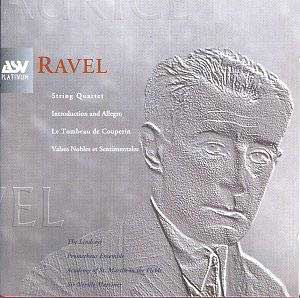ASV have assembled here a nice, varied selection of music by
Ravel and one which contains two of the finest works in the twentieth
century chamber music repertoire.
Ravel’s orchestral output is represented by the suite,
Le Tombeau de Couperin. This began life in 1917 as a six-movement
work for piano and the orchestration of four of the movements was done
two years later. Here the suite is freshly and immaculately played by
Marriner and the members of the Academy. The ‘Prélude’ has gaiety
and spirit. In the ‘Forlane’ the lilt of the dotted rhythms is done
perfectly while the ‘Menuet’ has all the necessary grace and eloquence
for what is after all a nostalgic expression of regret for friends and
times past. In this movement especially the poised phrasing of the ASMF’s
wind soloists gives great pleasure. To conclude, the scurrying ‘Rigaudon’
is zestfully played. This is a winning performance.
The String Quartet is entrusted to one of Britain’s
foremost quartets, the Lindsays, and is a splendid example of the great
artistry which they have displayed in a career now lasting for over
thirty years. This is an extraordinarily subtle score. As we read in
the brief liner notes "most of all the music’s joy lies in sheer
sound." It is clear that the Lindsays have studied the piece with
painstaking thoroughness and have got right inside the music. They call
upon the fullest possible range of timbres and I admired particularly
their intense, controlled quiet playing. Theirs is a performance which
is alive to every nuance and although all the incidental beauties are
revealed the reading is greater than the sum of its parts and, above
all, has a strong sense of flow and momentum.
In the work’s second movement they certainly obey Ravel’s
marking ‘très rythmé’. However, they convey just as successfully
the hushed, reflective music which lies at the core of that movement
(track 6, 1’ 48"). This passage has great tenderness in their hands.
They go on to give a deeply felt reading of the wistful and shadowy
slow movement. Here their tonal refinement is pretty marvellous and
the playing is compelling. "Compelling" is also, I feel, the
mot juste for their urgent account of the finale which sounds
just as Ravel intended, ‘vif et agité’. In summary, this is a
quite wonderful reading of the quartet and it alone is worth the price
of the disc.
Gordon Fergus-Thompson may not be a stellar name but
he is a fine pianist and he gives a sympathetic and involving performance
of the Valses. I must admit to a preference for the orchestral
version which Ravel made in 1912, a year after writing the original
piano work. However, in expressing that preference I don’t mean to imply
that there’s any lack of contrast or colour in Fergus-Thompson’s playing.
I find him particularly convincing in the slower sections such as the
‘Assez lent’ (track 10) but I do like the ‘give’ he imparts to the ‘Vif’
section (track 14). The concluding ‘Epilogue’ (track 16) is most atmospherically
done and on this showing Fergus-Thompson need not fear comparisons with
more famous pianists.
I think that Ravel’s Introduction and Allegro is,
quite simply, one of the supreme masterpieces of chamber music, and
not just of the twentieth century. It is a uniquely subtle and evocative
composition in which Ravel uses the contrasting timbres of his unusual
ensemble to stunning effect.
Here, the pellucid beauties of this extraordinary score
are realised exceptionally well by the Prometheus Ensemble. The players
sound as if they’re not just playing together but for each other.
The piece can seem like a mini-concerto for harp and ensemble. However,
although the playing of the un-named harpist (Caryl Thomas, I suspect)
is very fine, the contributions of the other players are just as sensitive
and as essential to the success of the enterprise. Clearly, a considerable
amount of detailed preparation has been done but the finished performance
flows effortlessly and with complete spontaneity. This is a very fine
performance which I enjoyed greatly and to which I will return.
The notes are short paragraphs which clearly have been
culled from the documentation of the original release. They are satisfactory
but no more than that and of limited help to anyone new to Ravel’s music
who buys this as an introduction to his oeuvre. The recorded
sound, taken from a variety of sources, is excellent throughout and
truthfully musical. I also like the stylish, silver packaging. All in
all, this is a most attractive and recommendable anthology.
John Quinn


